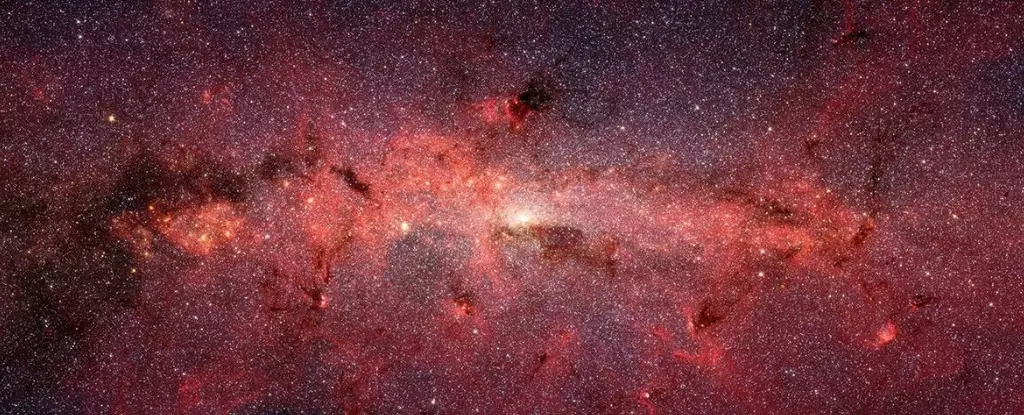Deep within the Milky Way resides a sprawling entity known as the Central Molecular Zone (CMZ)—a hub of cosmic chaos, dense gas, and eternal mysteries. Spanning nearly 700 light-years, this region is not only astonishing in scale but equally bewildering in its atmospheric phenomena, where the gases seem to dance to an unseen rhythm. What captivates the mind is how the CMZ exhibits an unusual rate of ionization, wherein hydrogen molecules are broken down into charged particles at an alarming frequency. This astonishing behavior has prompted astrophysicists and astronomers to embark on an investigative journey to unveil the potential forces at play.
While it’s understood that interstellar cosmic rays and starlight might contribute to this ionization process, they alone cannot account for the rates we’re witnessing. This leads us down a path of speculation, raising pertinent questions about the nature of our universe and its underlying mechanics. Is it possible that the CMZ is more than just a region of interstellar gas? What if it holds the keys to unlocking one of the universe’s greatest enigmas?
The Gamma Ray Mystery: A Cosmic Annihilation
Adding another layer of intrigue, astronomers have been detecting an unusual glow of gamma radiation, precisely measured at an energy level of 511 kilo-electronvolts (keV). This type of radiation generates when electrons collide with their antimatter counterparts, positrons, resulting in annihilation and a burst of gamma rays. Despite extensive observations since the 1970s, the origin of this radiation remains elusive, akin to capturing smoke with bare hands.
Proposals have included various astronomical phenomena such as supernovae, neutron stars, and black holes, yet no solution fully encapsulates the intensity or pattern of this emission. This lingering uncertainty not only fuels scientific curiosity, but it also serves as a constant reminder of our cosmic ignorance. What if, amidst our search for answers, two seemingly disparate phenomena—high ionization in the CMZ and the 511 keV emission—are linked by a common cosmic thread?
The Dark Matter Theory: A Hidden Culprit?
Enter dark matter, the invisible enigma that accounts for approximately 85% of the universe’s mass yet remains undetectable by conventional means. Imagine a substance that influences the gravitational forces of galaxies while eluding our attempts to see it; dark matter fits this description. Recent theories gaining traction consider light sub-GeV dark matter particles as potential players in the cosmic arena.
Researchers have pondered a theoretical interaction between these elusive dark matter particles and their antimatter counterparts. If they were to collide in the dense environment of the CMZ, would their annihilation events result in the swift creation of electrons and positrons? The implications of this hypothesis are profound. Not only could such interactions contribute to the high ionization levels observed, but they might also provide an explanation for the gamma rays that linger in the cosmic ether.
Connections Revealed: A Unified Cosmic Narrative
The fascinating synergy between ionization rates and gamma radiation might just represent a grand cosmic tale waiting to be unraveled. Detailed simulations reveal that dark matter annihilations could indeed account for the observed ionization profile within the CMZ. Moreover, as the positrons generated from dark matter interactions collide with electrons in their environment, a perfect setup for producing the enigmatic 511 keV gamma rays emerges.
This tantalizing link between two cosmic signals emerges as particularly striking and transforms the CMZ into an essential laboratory for studying the elusive nature of dark matter. The prediction of a flat ionization profile throughout the region aligns harmoniously with observations, challenging traditional models reliant on point sources such as black holes or stellar remnants.
The Horizon of Discovery: Future Prospects
For future explorations into the heart of our galaxy, the horizon appears bright, yet laden with challenges. Enhanced telescopes with superior resolution stand on the brink of revealing more about the intricate relationships between ionization rates and gamma ray emissions. These future observations could either solidify or dismiss the dark matter explanation, contributing to our broader comprehension of the universe and its astonishing complexity.
Ultimately, the dual mysteries of the CMZ present an opportunity not just for scientific advancement but as a call to embrace the unknown. The interplay between dark matter, ionization, and gamma rays signifies an adventure fraught with uncertainty and discovery. As we gaze upon the glowing core of our galaxy, it serves as a reminder of our shared curiosity and the inexhaustible quest for answers that continue beyond the frontiers of human knowledge. We might not have all the answers yet; still, the journey into the heart of darkness shines a light on the universe’s secrets, waiting patiently for us to uncover them.



Leave a Reply